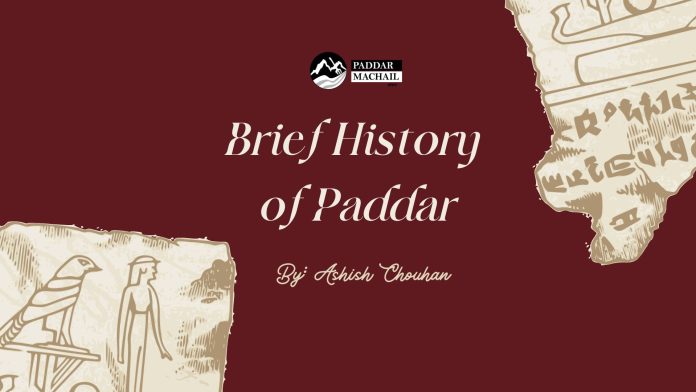History of Paddar: Introduction
Paddar, which today is popularly known by the name “The land of Sapphire”, is a tiny subdivision of Kishtwar District of the newly created UT, J&K. Nestled in the lap of lesser Himalayas and surrounded by the tall snow-capped mountains from all sides this region of the planet which remained unknown to the rest of the world for many centuries was brought to glory in the 1880s and 1980s by the discovery of world famous Sapphire Mines and with the commencement of famous Machail Yatra respectively.
Early History of Paddar
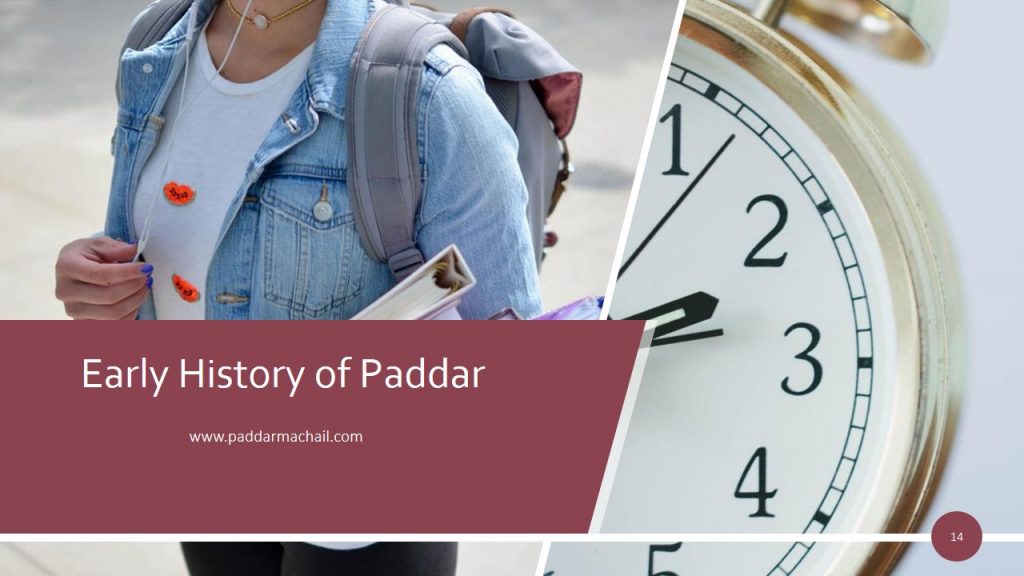
This region which remained isolated for centuries has its own unique culture and history. Though no concrete data is available about the early history of Paddar, but there are some records, forlorn stone fountains and early sculptures which suggest that this land was traversed if not inhabited by the people many centuries ago.
Geologically it can be speculated that this tract of land especially area in the vicinity of the today’s financial Capital of Paddar, Gulabgarh, was part of a lake thousands of years ago formed by the confluence of mighty river Chenab and its tributary Bhotnallah which originates in Paddar1. With the time this land of sand to a depth of about 10-12 feet would have been formed. For years this region remained untouched from the human activity.
Situated in the lap of Himalayas this region is rich in flora and fauna. Meadows in Paddar are widely known for their rich juicy grass. These meadows would have certainly allured cattle grazers from the surrounding areas to this land and which would have finally paved way for the inhabitation of the area in the later years. Pointing exact dates of such dwellings are unfeasible but it can be said that this all would have happened between 6th and 8th centuries CE.
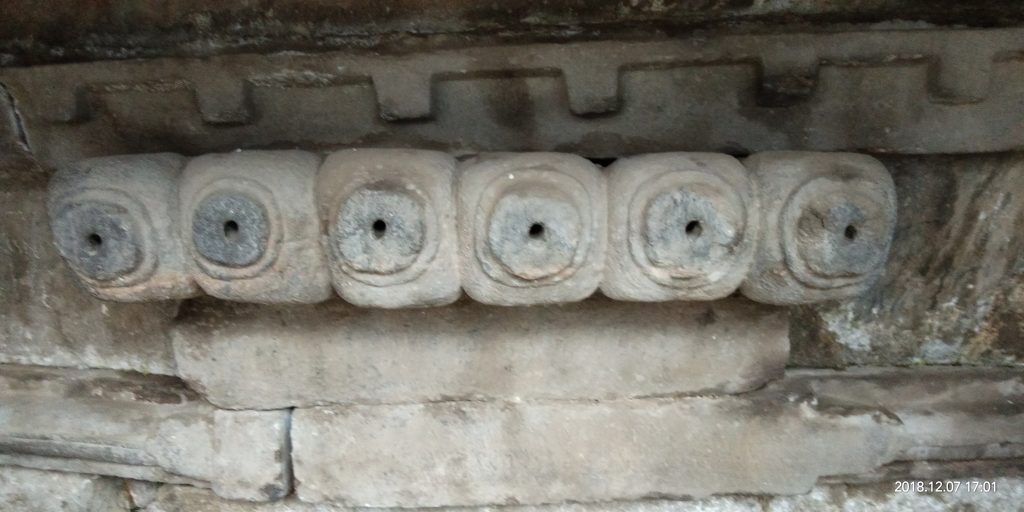
To the west there lies Nagseni, an area about 30 km away from Paddar, history of which dates back to around 200-300 BC. One of the Great Buddhist Monks Nagsen who wrote book Milindapanho was born there. Carving roads through the Himalayan Mountains especially Paddar would have been truly a daunting task but should it not be questioned that how an area which was only at a 30 km distance from an inhabited place remained uninhabited for years on end. Legends tell that stone fountains, popularly known as naurn in Paddar were built by Pandavas. Same structures can be found scattered in many areas neighbouring Paddar viz Pangi, Bhaderwah and Nagseni. It is true that these structures are centuries old and are a matter of research but calling these to the time of Mahabharata would not be sound as we have no data to justify this claim.
The etymology of the word, Paddar

Lush green pastures of Paddar attracted cattle grazers from the neighbouring areas viz. Zanskar, Bhaderwah and Pangi. Similarity in language and culture give testimony to this fact. Many propositions have been put forward by scholars for the word Paddar. According to S.D Vyas, word Paddar is comprised of two words PAA & DAR, the first one means a ‘foot or pul’ in the native dialect and the later stands for ‘the fear’ 2. Thus the meaning of word according to him loosely translates to a place which is full of adventures.
Learn about the present and future of Paddri dialect: Click Below:
Others suggest that its genesis is linked to the name “padhar” meaning meadow in Bhaderwahi and Pangi dialect. There is also a place in Bhaderwah by the name Padri meaning meadow and which justifies this proposition to some extent. Also, there is a place called Padum in Zanskar to the north of Paddar. This word Padum is also quite similar to the word Paddar. It is a point of coincidence or something else that names of some of the surrounding regions are quite similar to the name Paddar. This point has led many scholars to conclude that migration to this place Paddar would have had happened in the past mainly from these three regions and not from the western region i.e. Kishtwar.
Paddar under the Guge Rule
Tough terrain would have posed challenge in the beginning to those who tried to use it as a pasture land for their cattle but slowly when they got accustomed to it they finally made their attempt to settle near water sources in Paddar. Firstly, people would have come from Pangi and Bhaderwah areas in 8th and 9th centuries and from the Zanskar region in the beginning of 12th and 13th centuries or even later. That could be a reason why there is less Buddhist population in Paddar nowadays. Paddar was under the occupation of Guge Rule between 10th and 14th centuries who ruled from Zanskar region. Third son of Guge ruler Nyima Mgon was Ide Gtsug Mgon who received Zanskar when his father spilt his vast kingdom and distributed it among his three sons in the 10th century.
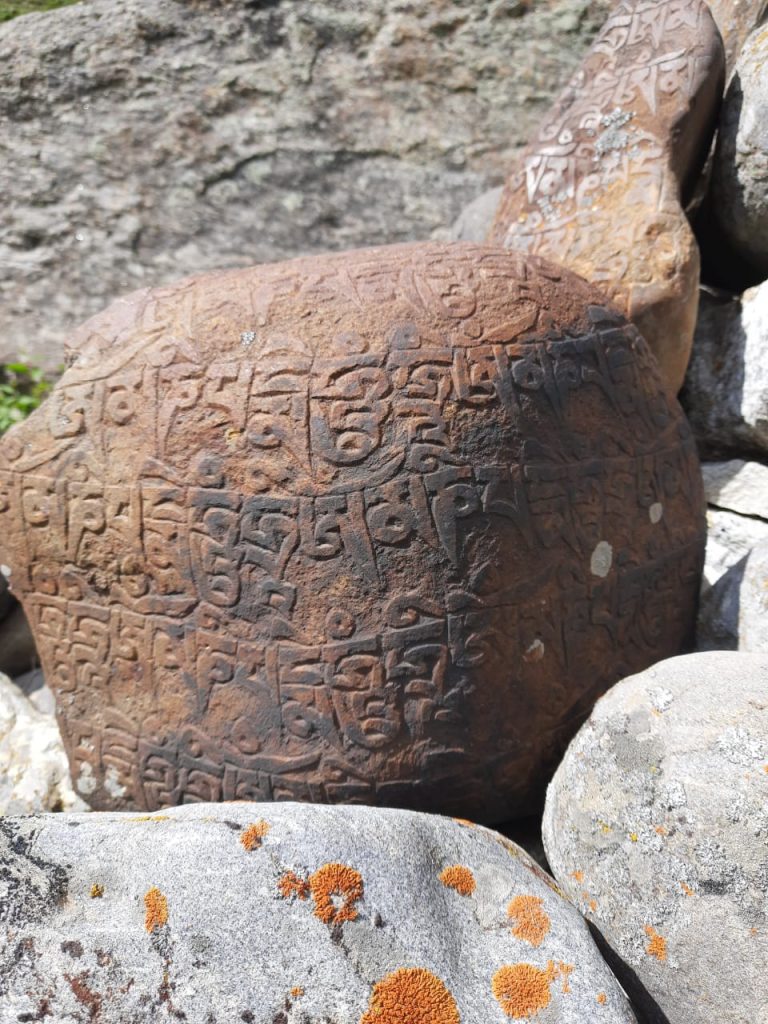
Dangerous path via Umasi-La was used by the forces of Guge Regime to reach Paddar. This path brought finally with itself people from Padum who used to trade in some essential commodities. Slowly people began to settle in the higher reaches of Paddar viz Sumcham Haloti, Tun etc. This route would have first brought Buddhism to Paddar. As this path which is situated at the height of about 17370 feet above sea level remains under the snow, it becomes difficult to traverse through it for more than half a year. Although petty Ranas or local leaders would have ruled lower Paddar from the beginning due to its geography but this area can be said to have remained under the influence of Guge rule till the end of 14th century. There are no stories of loot and plunder under the Guge regime.3
Transition into the Medieval Period
Due to rugged topography Guge Rulers couldn’t maintain tight control over the mainland Paddar. Only few villages of the higher reaches of Paddar could have fallen into the jurisdiction of the Guge Empire and which too due to the mercantile activities of the people from Padum. Rest of the Paddar was under the rule of petty Ranas whose dominions could not exceed 5 villages. There happened to be a head (Rana) in every two-three villages who managed affairs in the areas from the beginning of the 10th century.
Economy of Paddar in the Medieval Period
Agriculture was the primary source of activity in the villages. Spending entire day with cattle, goat and sheep would have kept them hand to mouth for the entire summer months. During winters, produce from the field viz. pulses (expect Rajmah), dhlesh, rice, Kodra etc would have kept their house hearth burning. Barter system was followed by the villagers.

This agrarian economy of the medieval villages of Paddar was controlled by the petty Ranas of the region. It is likely that these Ranas would have collected revenue in kind from the villagers. There happened to be competition among these Ranas for that and which often resulted in the rivalry between them.
Attacks on Paddar from the west and increase in the power of Ranas.
Paddar from Ishtyari in the east to Sazar in the West and Sumcham to the North remained totally under the influence of local Ranas. In the middle of 14th century Raja Sangram Singh of Kishtwar attacked Sazar and added it into his dominion. His return to Kishtwar after that which brought relief for the rest of the Ranas of Paddar who hoped that the danger has stalled.4
After that Kishtwar state came under the rule of Raja Rai Dev. It was in the middle of 15th -16th centuries that first major attack on Paddar happened from the west under the Wazir Mangal Rai of ruler Raja Rai Dev. While on the expedition he defeated the Ranas of Jar and Kadhail and brought villages of jurisdiction under his master’s rule.After that he also returned to Kishtwar sparing rest of the Paddar. He took large number of animals consisting of cows, bulls, sheep and goats along with him but this saved other Ranas from his wrath5.
You can also find a lot on information on Paddar in this book by Eminent Historian from Kishtwar Sh.DC Sharma Ji:

There remained peace in Paddar for the next one century but Ranas who saw this scathing attack debilitating their homeland laid stress on increasing their power. They revised their tactics and went on to increase their influence to save their land from further attacks. Ranas of Paddar could not take peace for granted and hence their attempt to bring more villages under their dominion seems justified.
There are some stories regarding these petty Ranas who strived to increase their influence. Rana of Leondi Sheetal Singh and Rana of Sohal Sudama were two of them. Rana Sheetal Singh brought the entire region from the immediate north upto present Gulabgarh under his control. Rana of Sohal with the help of his son brought entire Eastern region upto Ishtyari, Gandhari under his control. With this rose two powers in the small region of Paddar.
The rivalry between Rana of Leondi and Rana of Sohal.
With the rise in power, the enmity between the Ranas of Sohal and Leondi also rose. Rana of Sohal might have coveted the sandy plain area of present Gulabgarh which Sheetal Singh considered part of his property. Sheetal Singh could not give direct fight to the Rana of Sohal so he targeted his main warrior friend BhotPlanch. Bhot Planch lived at Kabban. Being a good friend of the Rana of Sohal, BhotPlanch was a brave warrior. It would not be wrong if you call Bhot Planch a “Beast”. The rivalry of the Rana of Sohal with the Rana of Leondi, Sheetal Singh made Bhot Planch appear before the scene. He was the Commander and friend of the Rana of Sohal Paddar.
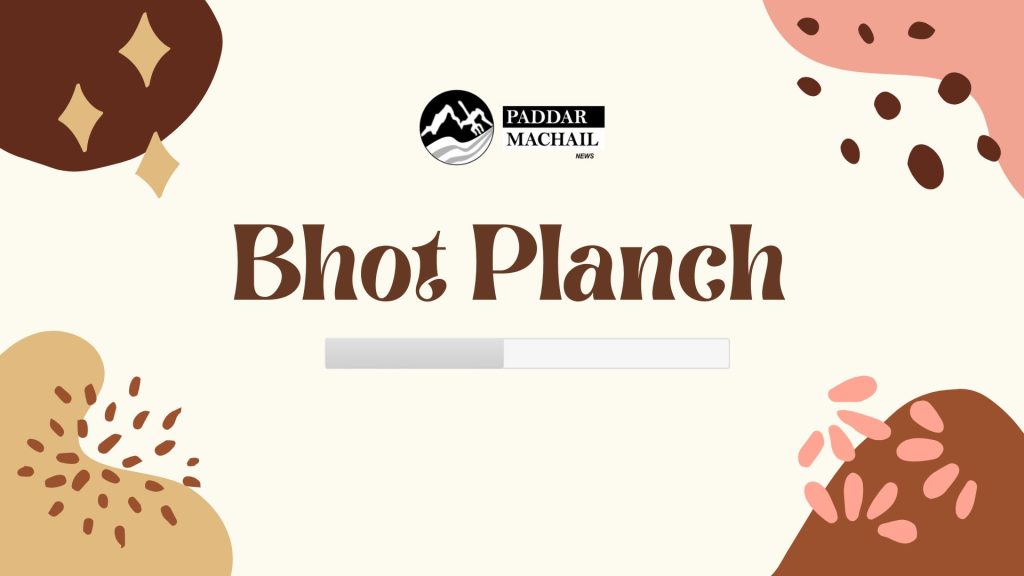
It is said that he was the inhabitant of Lahul (a place in Himachal Pardesh). His friendship with the Rana of Sohal brought him to Paddar. He was given the village of Kabban to rule by the Rana of Sohal village. It is proposed that Buddhist migration from Pangi region would also have happened during this period to the Kabban region of Paddar. Bhot Planch was one such warrior who came from Lahul region.
He maintained a long tuft of hair like Chanakya. His lifestyle was weird. He slept less and ate less salt. His look itself would have instilled fear in the people. It is said of him that his uncanny habit of taking less salt with food aided him to conquer his sleep. One could have found him awoken all night guarding the fort.
Know the geography of Paddar in 4 minutes. Click here:
There happened many group fights between the two Ranas. Sheetal Singh failed multiple times in the skirmishes that happened between the two little armies. One such fight happened at a place called Raktal in Sohal Paddar which routed his army completely and resorted him to adopting some unfair means. He grew anxious and hatched a plan to kill Bhotplanch. By resorting to unfair means he succeeded in manipulating BhotPlanch’s wife. One day in the dark of Night Sheetal Singh killed Bhotplanch with the aid of his treacherous wife.
This brought to an end the main commander of the Rana of Sohal. Sheetal Singh who had defeated many other Ranas with such tactics constructed a fort at a place called Dumair (at the confluence of River Chenab and Its tributary Bhot Nallah, presently Gulabgarh). Thus Mini-Capital rose around the fort and it was named Sheetalgarh after his name. On the other hand, Rana of Sohal along with other defeated Ranas approached Chattar Singh, the Ruler of Chamba and invited him to attack Paddar.
Chattar Singh and the Battle of Sheetalgarh
Stories tell that friendly relations of Rana of Sohal were good with the Ruler of Chamba. When Rana approached Chatter Singh in the middle of the 17th century, he sent his army to his aid to attack Sheetalgarh. Sheetal Singh was unaware of such plans. In the middle of night there happened a surprised attack at Sheetalgarh. Half of his army was finished by the time there rings an alarm of danger. Sheetal Singh fought bravely but succumbed to his injuries later on.
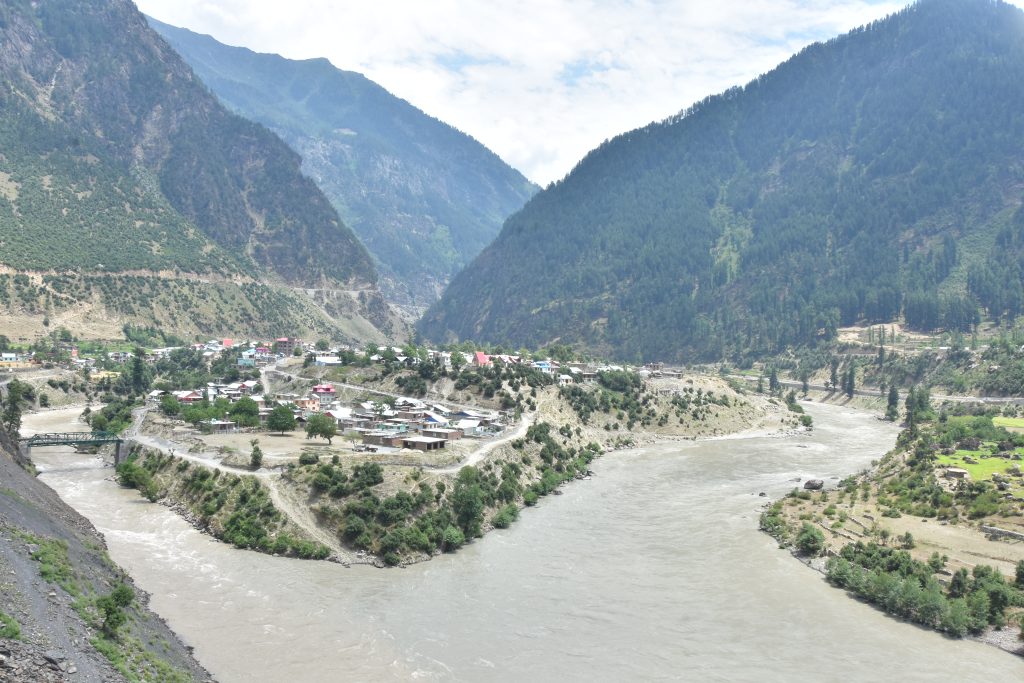
A fort erected by Sheetal Singh was demolished and a new fort was constructed in its place. It was named Chattergarh after the name of the ruler of Chamba. A small unit of the Chamba army stationed at Sohal Paddar. It is said that it were they who first constructed a small Maa Kali Temple there. An old order of Ranas was restored by placing the entire region of Paddar under the Chamba rule. Ranas of Paddar were made Kardars or revenue collecters in their own estates.
Art and Achitecture during this period
There are many stone sculptures and pillars which belong to this region. There is one Nandi Bull (Consort of Lord Shiva) stone Sculpture at Leondi. It is a workmanship of local artisans and most probably this would have been constructed at the time of Rana Sheetal Singh.
Another stone ditch or pit can be found at Sohal. It is around 9-10 feet deep conical pit constructed in the middle of 17th century to mainly store water for the times of emergency. Other temple deities are also found carved on the wooden pallete of temples all across the Paddar. There is one flat sandstone in Ungaie Paddar also on which different deities have been carved.
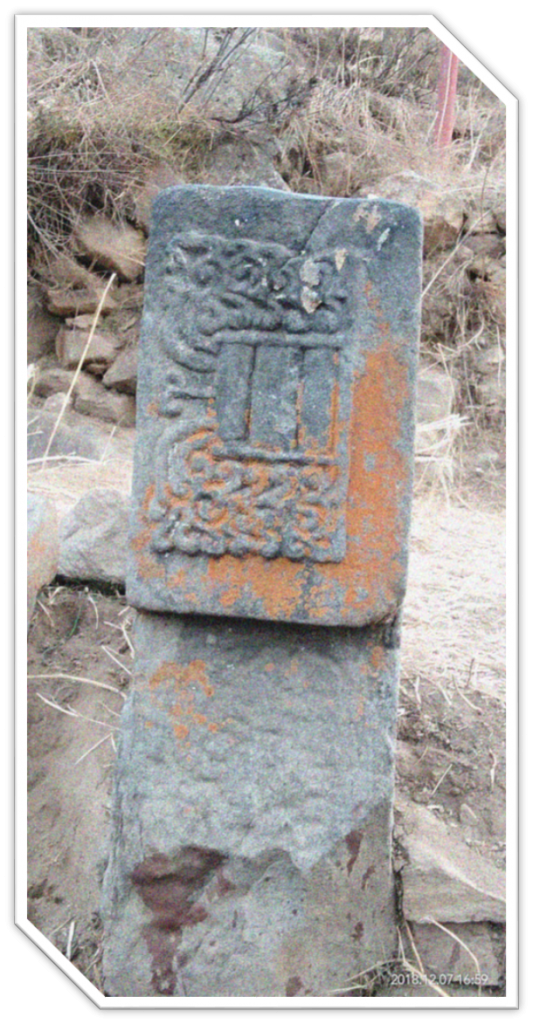
Along with that design of Kothis where people lived, Kutnyalis where people crushed their grains and Ghirats where people made flour of grains is also notable.
Many kitchen implements like ghueal (used for pouring Ghee), many tools used for worshipping called Sandhel and use of many other things like tazane (metallic rods) in temples are also intriguing.
Social Practices and Customs
Wheels of the society of Paddar in this period moved on the track of traditions and norms. Every aspect was dictated in terms of legends. Winters kept people of this region confined to homes and process of cleansing these homes cum kothis came to a grinding halt for the entire period. With the dawn of summer months there began the tradition of throwing Hyun.
Literally meaning of this word is associated with snow but in this sense here it means filth that accumulates in the winters due to uncleanliness and practice of throwing that smut with the dawn of summers got cemented in the social fabric of Paddar in the form of a ritual. This practice which continued till modern times worked as a reminder of cleanliness in the past.
Festivals played the role of glue in binding the people of different villages. They enabled people to forge strong familial ties as well. Festival of Awaans is a prime example of this. Its genesis is linked to the legend of marriage between a boy of village Sazar and girl of village Dhyaan in Paddar. Awaans is still celebrated in Paddar in the memory of the familial ties forged in the past. This reminded people of the importance of sanctity of such relations.
There emerged many rituals and festivals in Paddar based on the personal experiences of dwellers, each serving some purpose in the evolution of the society of Paddar.
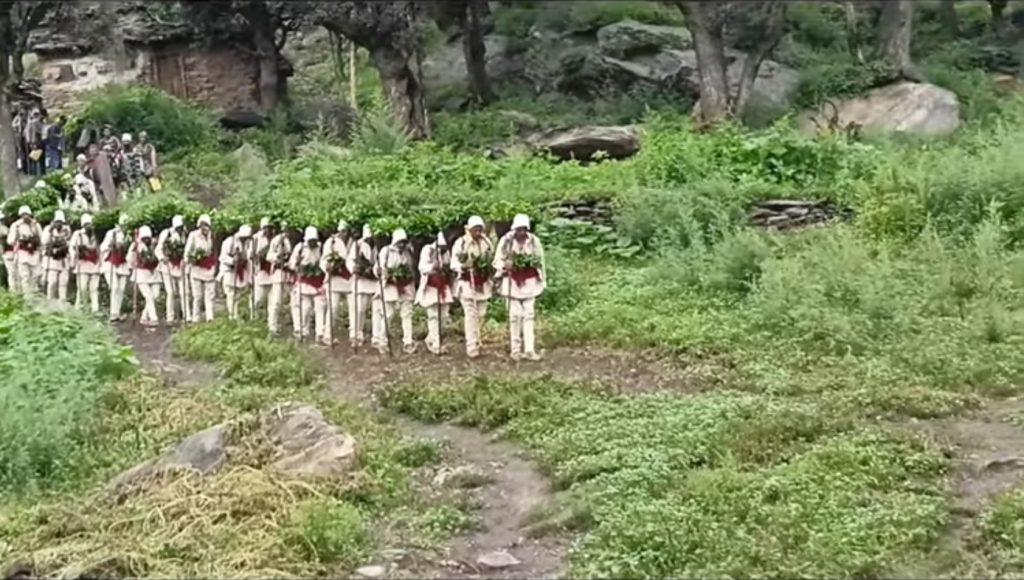
There although existed some practices which played their role in keeping Paddar backward viz Sati Pratha, Caste System and superstitions.
From the ancient stone Pillars at Sohal Paddar and few other villages it can be argued that Sati system was prevalent in Paddar. People were used to building large stone pillars in the memory of those women who went Sati with her husbands. This practice died with time due to social reforms that happened in the country.
As we know that present is an outcome of past. It can be claimed from this logic that Caste system was deep rooted in the medieval society of Paddar. There were Brahmins, Khatris and Shudras in Paddar and discrimination with shudras happened on a wide scale. There were separate cremation grounds constructed for them and their functions were barely attended by the rest.
Study in detail about the Festivals celebrated in Paddar: Click Here:
Superstition in Paddar had also large tentacles. It played a great role in hindering the progress of developing society. Black magic, sorcery, animal sacrifices at temples on large scale were part of the society. There is a one story of the Rana of Garh whose superstitious mind was convinced to such an extent by the superstitious society of that time that he agreed to kill her daughter-in-law on the pretext of sacrifice done in order to restore the main canal which was blocked due to some natural cause.
One bizarre ritual called Mundyar Shau was also prevalent at Tatta Pani. During this ceremony it is said that 100 sheep were slaughtered in the name of sacrifice to keep the monster happy who was believed to bring bad fortune for the villagers.

Nomenclature of many mountains have been done after the name of monsters. Mountain above Tatta Pani is called Dhadbhadek and above Matti area is called Dhuauzz. These sacrifices are done in order to keep them happy. It is believed that if such sacrifices are not made Paddar will face the onslaught of these demons or something inauspicious will occur.
People of Paddar were also accustomed to some traditional games viz. Santooli, Churu, Hamla etc. These games have flexed muscles of this region from generations. They have grown up while playing these and many such games are still in practice in Paddar.
Wine and Dine
Food reveals a lot about the society. It is expected that crops like Kodra (Kodo Millet), Dhlesh, Pulses, Barley, Paddy, Wheat were grown by the people of Paddar. People were mostly accustomed to meat and milk products. Many rituals and traditions related to milk products have stuck with them from the very beginning. Apart from that other vegetables and spices that the Himalayan forests wrought were also part of their cuisine. Intoxicating drinks also found their place in the society of Paddar. Chang being popular in the higher reaches.

Pots used for cooking food were not that advanced. Animal skins were used for the transportation of butter milk or other milk products from one place to another. Soil Pots were used as containers for the storage of water and other things. Ladles and other kitchen implements were probably made of wood. Ghirats (moving wheels) were in use for turning grains into flour and big Kutnyalis (kind of stone thrashers) were in place for thrashing skinny grains. Other natural products like Ghughutak and khyds were used as soaps to wash clothes or for bath.

Supply of salt, jaggery and other products (that were not made or found in Paddar) to Paddar were likely to have had happened from the northern and eastern side that is from Zanskar and Chamba respectively. The road was harsh and ponies and cattle were used as load carriers.
Mustard oil was not in use in place of it ghee (purified form of butter) was used for cooking food. Apart from this, Sattu (made from Barley) was the main ingredient which people from that period used.
Transition into modern Period
After the invasion of the Chamba King Chattar Singh and construction of fort at Gulabgarh called Chattergarh fort, Paddar lived a peaceful life till the beginning of first two decades of 19th century. Lots of developmental work took place during this time. By then many crops were introduced in Paddar viz. Maize and Potato, thanks to its constant touch with the Chamba principality.
It was 1821 AD when Kishtwar state was being ruled by the last ruler of Kishtwar Mohammad Teg Singh. Expansion of Dogra state was happening rapidly and dogra forces under the command of Dogra General Zorawar Singh Kalhuria were on the spree. Raja of Kishtwar also confronted the forces of Dogra Maharaja Gulab Singh. His defeat was inevitable therefore he surrendered on the face of it but one of his wazir could not digest all that and therefore fled to Chamba and sought refuge under the then Raja of Chamba, Charat Singh.6
More about the Political Figures of Paddar who shaped the Paddar’s History. Click below:
The Raja of Chamba appointed him the chief official of Paddar. In about 1825 A.D. he annexed Padam and added it to the territory of Chamba. This achievement of him made him famous and earned him the name of Rattnu Palsar in Paddar.7
Later in 1835 AD when some 30 soldiers of Maharaja Gulab Singh were stationed at Chattergarh by the two of his Generals from Kishtwar Mehta Basti Ram and Wazir Lakhpat Padiyar to keep up communication with the Zanskar when they came from there via Umasi-La8. Rattan Singh got worried when he saw that positioning of Dogra soldiers at Paddar.
He feared that Dogras might crush him any time and add Paddar to the Dogra state. Rattan Singh repudiated this act of theirs and therefore later when Zanskar raised the banner of revolt against Dogra rule, he exploited this opportunity and arrested the Dogra soldiers with the aid of local forces and sent them to Chamba as prisoners. This act of him invited the wrath of Dogra General Zorawar Singh to Paddar.
Dogra General Zorawar Singh Kalhuria attacks Paddar
Zorawar Singh Kalhuria who was born in 1784 AD in the Bilaspur state of Himachal Pradesh was the tall General of Maharaja Gulab Singh. When the news of Rattan Singh that he had captured Dogra soldiers from Chattergarh reached his ears he marched towards Paddar with his band of 3000 soldiers in the spring of 18369.
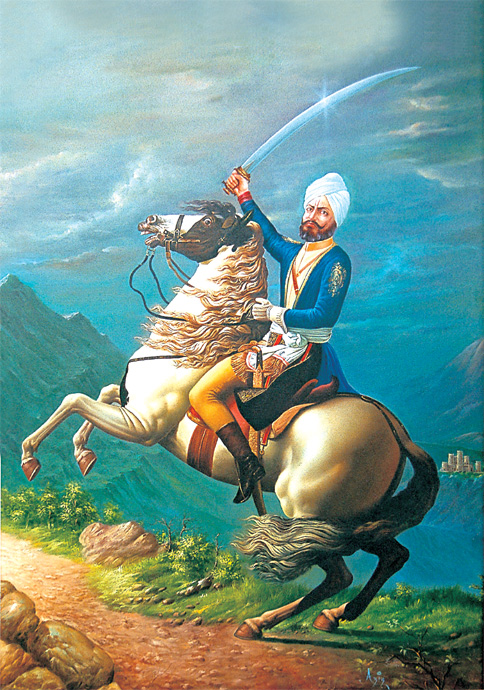
He reached Paddar from the west. Forces of Rattan Singh who were expecting this and were wary of this destroyed the only bridge on river Chenab. This move of Rattnu Palsar kept Dogra forces away for about three months. Finally one day Dogra forces faked the events at Atholi Paddar and managed to build a rope bridge across the tributary of River Chenab called Both Nallah. Local forces did not expect this and got surprised at this sudden attack.
Forces of Charat Singh under Rattan Singh’s command suffered a humiliating defeat at the hands of Dogra general and Paddar was added to the Dogra state in 1836 A.D. Local forces were disfigured by the him in order to instil the sense of dread among locals so that no one would raise a banner of revolt against the Dogra state in the future.10
Fort built by the Chattar Singh at Chatter Garh was brought down by him and its name was changed to Gulabgarh once and for all during this period. Rattan Singh was taken as prisoner to Jammu by him though he was set free by Maharaja Gulab Singh later.
How many villages are there in Paddar? Click below:
There is a story that one day when Rattnu Singh’s master (the Raja of Chamba) and who gave him shelter and Paddar to rule for a brief period, died and when this news reached his ears while in Jail he refused eating and have his head shaven in grief. While looking at this Maharaja Gulab Singh’s heart filled with compassion and he ordered his release from the jail. He gave him an estate to rule in Kishtwar.
After crushing rebellion in Paddar Zorawar Singh went to Zanskar to crush the rebellion there via Umasi- La. He restored peace there and went back to Kishtwar.
While he was in Kishtwar in 1837 AD news of rebellion in Leh again reached his ears. He marched towards Leh and it is said that he covered the entire distance from Kishtwar to Leh in 10 days.
After that on his return from Leh he also built a fort at Chishoti Paddar in 1838 A.D. Paddar and Zanskar both became part of the Dogra state and were given status of Tehsil under the rule of Maharaja Gulab Singh in 1845 AD.
Discovery of Sapphire Mines in Paddar
There are many stories which revolve around the discovery of these classified sapphire mines. One version tells that the steps towards the detection of these mines were initiated in 1881-82 after some pieces of blue stone were purchased by some Laholi traders (who later on sold these in Shimla) from the local hunter of Sumcham village. Hordes of people came in Paddar thereafter in search of these mines once its value was recognized. Initially they confused Paddar to Padam (an area in Ladakh) but managed to find the place later. They took a large quantity of Sapphire to Lahul where they sold these precious stones at absurdly low prices.
It is said that during those times people from Padum ( Zanskar) used to trade in salt and other items in Paddar and a sack full of raw stone collected from Sapphire Mines were exchanged in lieu for a sack full of salt.

When this news hit the ears of the then Maharaja of J&K (under whose jurisdiction this area lied) he immediately stationed his troops near the mines. By leaps and bounds work at Sapphire Mines started in 1882. It is said that 72,207 tolas of Sapphire of worth 4 lakh rupees were yielded during 1882-83. Those were the days of Glory for Maharaja and place Paddar. Stones as big as 6’’ to 3” were discovered during this time which earned name and fame for Paddar. By the end of the decade in 1887 revenues from the mines started waning.
Taking serious note of this Maharaja Ranjit Singh sought help from the then Indian Government. To his aid British Government sent an expert geologist Mr Tom D. LaTouche to J&K. His survey revealed that the mines had run out of its resources and that only floor mining could yield more if done. At that time there was a feeling of mistrust among the British Government officials for the Maharaja of Jammu and Kashmir due to his chumminess with the Russians. Taking this into consideration they exercised direct control over J&K during this period because of which work at the Sapphire Mines halted between 1989 and 1905.
You can also watch this video to know the History of Paddar Sapphires in depth:
These mines were leased out to the Kashmir Mineral Co. and CMP Wright between 1906 and 1908. In 1909 a department of mining was established which was named later on as J&K Minerals Limited. In between 1909 and 1932 many other people from Jammu and Kashmir visited these mines. The mining work stopped for two decades thereafter.
Political History of Paddar
Political history of Paddar has remained a turbulent one. From being a local unit of Ranas to becoming a Tehsil of Kishtwar District it has seen many ups and downs.
In 1845AD Paddar was given the status of Tehsil under the reign of the Dogra Maharaja Gulab Singh. Later in the period of Maharaja Ranbir Singh when Zanskar was added to Leh, Paddar was added to Kishtwar Tehsil. Hence Paddar which was earlier a tehsil and of which Zanskar was a part now itself became a part of Kishtwar Tehsil.

In 1963 it was given the status of Block by the then Govt. of J&K. Paddar was then a Niabat Headquarter. Surrounding regions viz. Chamba and Zanskar which were akin to Paddar in terms of development and infrastructure, flourished due to the grant of Scheduled Tribe Status. Paddar struggled for this status since 1986 but could not succeed in its attempt.
People of Paddar struggled and after great chest thumping Tehsil status was finally restored to Paddar region in 2005 AD. Now there are two Tehsils in Paddar viz. Atholi and Machail.
In 1986 the then Governor of J&K visited Paddar. High School Atholi was upgraded to Higher Secondary School. Along with that multiple funds were also granted for the development of Paddar area.
You can also read an article on the development of Paddar, published in Daily Excelsior Newspaper by Ashish Chouhan. Click below:
There were three Panchayats in Paddar Block viz. Atholi, Sohal and Massu Panchayat. When first Panchayati elections were held in Paddar in 1957, Sh. Prem Lal from Atholi was chosen as Sarpanch of Atholi Panchayat, Sh. Jwala Das from Ligri was chosen as Sarpanch from Massu Panchayat and Sh. Ram Dayal from Sohal Paddar was chosen Sarpanch from the Sohal Panchayat.
After that 2 more Panchayats were formed in the later period. Now there are 13 Panchayats in Paddar Subdivision.
Roads in Paddar
Paddar was not connected with motor able road earlier. People used to cover entire distance by foot in the past. It was dangerous to traverse through this rough and bumpy road. Loads of salt bags were brought on cattle backs from Thatri and other regions to Paddar. It was in 1989 that people first saw vehicle in Paddar when it was connected with roads by BRO under GREF.
The then Governor of J&K Sh. K.V Krishna Rao visited Paddar and inaugurated this road for the public transport. Later on this road went upto Sansari Nallah. Bridge over river Chenab was constructed and development in Paddar picked up pace.
Today we can see a new road through upper Ishtyari being constructed to avert movement through the world’s 3rd dangerous road that is Cliff Hnager Road. Work on many link roads are also in progress. Many new roads have been sanctioned but it is unfortunate that many regions of Paddar viz. Ungaie, Gandhari, Pallali, Machail are still unconnected with motor able road.
Terrorist Attacks in Paddar
When militancy was at its peak in 1990s Paddar also faced the impact of it. Three areas of Paddar came under the attack of these terrorists viz. Sazar, Chitto and Atholi region.

In Sazar 7 innocent lives were taken by the terrorists. These terrorist used to roam in the Himalayan jungles. People of Atholi Paddar who had their Puhali (makeshift houses in the higher reaches to facilitate the movement of their cattle) in the Sharoth region of southern jungles also faced an attack in 2001 AD. In this fatal attack 13 innocent people were brutally killed by the terrorists at point blank range.
More about the History of Sharoth Dhar Massacre is here:
In Chitto, terrorists also entered from the upper reaches. They forced local inhabitants to carry their luggage. There didn’t happen any casualty in this case though but it also panicked Paddar for a brief period. Stern action of army and formation of Village Defence Committees (VDCs) in every village later on stopped the terrorist activities in the region.
Calamities in Paddar
Paddar has faced many adversities. It is a known fact that Paddar is situated in the lap of lesser Himalayas and many villages in this subdivision are situated in the upper reaches of Paddar near to colossal glaciers and areas which are prone to deadly avalanches. In these higher reaches timber was usually used for constructing kothis ( typical Paddri name for houses).
In the ending months of 1963 AD many houses in Sohal Paddar caught fire. Whole village was destroyed by the flames when this fire broke out in the village. Many other such incidents have taken place in other regions of Paddar viz Ungaie etc also where many houses were burnt down.
One cipf-es.org another incident happened in Paddar which shook the Paddar region from the very base. It was year 1989 AD when one avalanche changed its course and swept the entire Bhatwas village in Gandhari Paddar. It was a first natural calamity of this kind that Paddar faced. In this natural calamity about 40 people got killed.

It is a well-known fact that roads of Paddar are prone to accidents and many accidents have occurred on these roads. It is unfeasible to make a list of all such accidents. But there is one such which happened in 2006 AD when one ill-fated bus Karan rolled down from the road and fell into river Chenab in the Shashoo region of Paddar. In this accident about 47 people were killed. This accident sent shock ripples across the length and breadth of Paddar.
If you want to add more facts and figures to swell the history of Paddar. Please send your suggestions on our email paddarmachail@gmail.com or you can simply comment below!
This gives us hope to work more for Paddar! Thank you so much!


